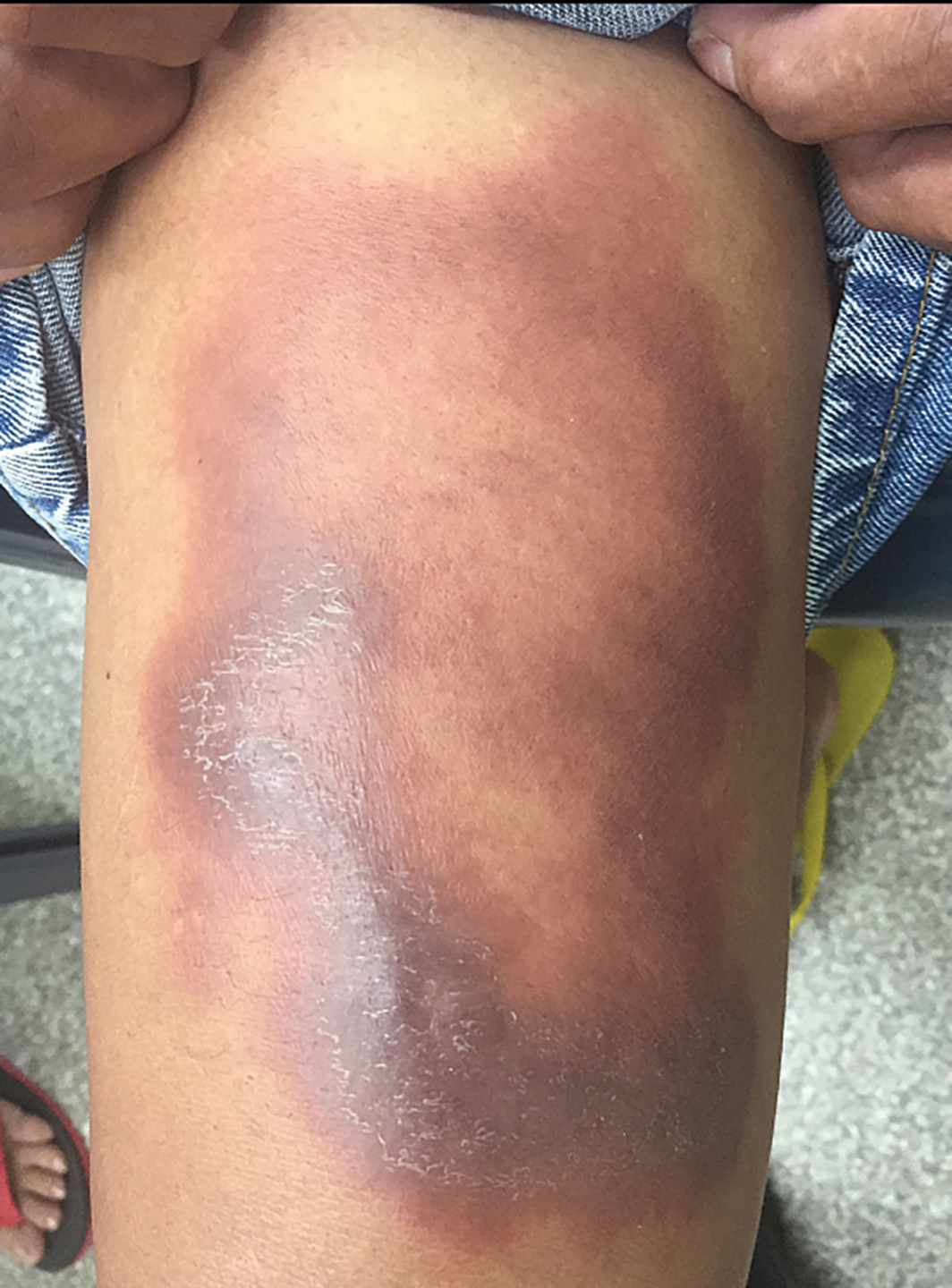People with leprosy, a chronic granulomatous disease caused by Mycobacterium leprae, classically present with hypopigmented or erythematous, anaesthetic skin lesions (Box 1) or thickened peripheral nerves. Leprosy can be cured with antibiotics, but severe deformity and long term disability are common if therapy is delayed.
Leprosy is now very rarely acquired in Australia, but it is still diagnosed; Indigenous Australians in remote locations bear the greatest burden of disease.1,2 Historically, its incidence has been highest in the Northern Territory, but cases are also diagnosed in Far North Queensland (FNQ), a region that adjoins Papua New Guinea (PNG), where leprosy remains endemic.3
Since 1985, Torres Strait Islander Australians and PNG nationals have been able to move freely across the border to pursue traditional activities in the Torres Strait Protected Zone. This arrangement acknowledges the importance of their shared cultural history, but also means that FNQ clinicians may encounter conditions that are rare in temperate Australia. The potential public health implications are also clear.4
To evaluate the epidemiology of leprosy in FNQ, we retrospectively reviewed all laboratory‐confirmed cases diagnosed in the region during 1989–2018. The Far North Queensland Human Research and Ethics Committee provided ethics approval for the study (reference, HREC/18/QCH/107).
Twenty cases of leprosy were identified in the Queensland Health Notifiable Conditions Register (Box 2). The median age of the patients was 26 years (interquartile range, 16–36 years); 11 patients had been born in Australia, including seven of nine Torres Strait Islanders (but no Aboriginal Australians). Apart from 1989 (six cases) and 2017 (three cases), no more than two cases had been notified in a single year. The most recent Australian‐born patient was a 28‐year old Torres Strait Islander woman diagnosed in 2009; she had had close contact with a person with leprosy born in PNG.
The low numbers of cases of locally acquired leprosy in FNQ reflect improved access to treatment and less household overcrowding, factors that reduce M. leprae transmission. However, while there has been no case of locally acquired leprosy since 2009, two PNG‐born Torres Strait Islanders were diagnosed with the disease in the past decade. The continuous flow of people between Australia and PNG makes ongoing vigilance essential.
Leprosy remains a significant problem in PNG. In 2015, 388 new cases were notified, and the annual number has changed little over the past decade.3 Australia will provide an estimated $608 million in development assistance to PNG during 2019–20,5 some of which will be used to strengthen its struggling public health system, and non‐government organisations involved in containing leprosy will also receive funding.6 However, more could be done. Leprosy is a disabling and infectious condition that can be rapidly cured. Public health programs have dramatically reduced the burden of infectious diseases in Australia. More support for similar programs in PNG will not only help our nearest neighbours, but also reduce the risk that infectious diseases almost forgotten by Australians will re‐appear.
Box 1 – Skin lesion on the thigh of a patient diagnosed with leprosy in Far North Queensland*

* The coppery, hypoaesthetic patch had been present for several months; biopsy confirmed multi‐bacillary leprosy. ◆
Box 2 – Demographic characteristics of people diagnosed with leprosy in Far North Queensland, 1989–2018
|
Notification |
Age (years) |
Sex |
Country of birth |
Indigenous status |
|||||||||||
|
|
|||||||||||||||
|
1989 |
20 |
Female |
Australia |
Torres Strait Islander |
|||||||||||
|
1989 |
48 |
Male |
Australia |
Non‐Indigenous |
|||||||||||
|
1989 |
46 |
Female |
United Kingdom |
Non‐Indigenous |
|||||||||||
|
1989 |
21 |
Male |
Australia |
Non‐Indigenous |
|||||||||||
|
1989 |
24 |
Male |
Australia |
Non‐Indigenous |
|||||||||||
|
1989 |
17 |
Male |
Australia |
Non‐Indigenous |
|||||||||||
|
1993 |
6 |
Male |
Australia |
Torres Strait Islander |
|||||||||||
|
1994 |
13 |
Male |
Papua New Guinea |
Non‐Indigenous |
|||||||||||
|
1994 |
11 |
Male |
Australia |
Torres Strait Islander |
|||||||||||
|
1995 |
30 |
Male |
Australia |
Torres Strait Islander |
|||||||||||
|
1997 |
16 |
Female |
Australia |
Torres Strait Islander |
|||||||||||
|
1997 |
33 |
Male |
Vietnam |
Non‐Indigenous |
|||||||||||
|
2002 |
33 |
Male |
Laos |
Non‐Indigenous |
|||||||||||
|
2003 |
20 |
Male |
Australia |
Torres Strait Islander |
|||||||||||
|
2009 |
28 |
Female |
Australia |
Torres Strait Islander |
|||||||||||
|
2009 |
13 |
Female |
Papua New Guinea |
Torres Strait Islander |
|||||||||||
|
2017 |
35 |
Male |
Papua New Guinea |
Torres Strait Islander |
|||||||||||
|
2017 |
53 |
Male |
Papua New Guinea |
Non‐Indigenous |
|||||||||||
|
2017 |
48 |
Male |
Philippines |
Non‐Indigenous |
|||||||||||
|
2018 |
36 |
Male |
Bhutan |
Non‐Indigenous |
|||||||||||
|
|
|||||||||||||||
|
|
|||||||||||||||
Received 27 February 2019, accepted 29 April 2019
- 1. Centre for Disease Control (Northern Territory Department of Health). Guidelines for the control of leprosy in the Northern Territory: version 3.0. Updated 28 May 2018. https://digitallibrary.health.nt.gov.au/prodjspui/bitstream/10137/526/3/Control%20of%20Leprosy%20in%20the%20Northern%20Territory%20Guidelines.pdf (viewed May 2019).
- 2. Mak D, Platt E, Heath C. Leprosy transmission in the Kimberley, Western Australia: still a reality in 21st‐century Australia. Med J Aust 2003; 179: 452. https://www.mja.com.au/journal/2003/179/8/leprosy-transmission-kimberley-western-australia-still-reality-21st-century.
- 3. World Health Organization. Global Health Observatory country views: Papua New Guinea statistics summary. Updated 8 Feb 2019. http://apps.who.int/gho/data/node.country.country-PNG?lang=en (viewed May 2019).
- 4. Brolan C, Upham S, Hill P, et al. Borderline health: complexities of the Torres Strait treaty. Med J Aust 2011; 195: 503–505. https://www.mja.com.au/journal/2011/195/9/borderline-health-complexities-torres-strait-treaty.
- 5. Department of Foreign Affairs and Trade. Overview of Australia's aid program to Papua New Guinea. 2019. https://dfat.gov.au/geo/papua-new-guinea/development-assistance/pages/papua-new-guinea.aspx (viewed May 2019).
- 6. Department of Foreign Affairs and Trade. Non‐government organisations. 2019. https://dfat.gov.au/aid/who-we-work-with/ngos/Pages/list-of-australian-accredited-non-government-organisations.aspx (viewed June 2019).





No relevant disclosures.■